You have probably heard about the uniqueness of Australia’s wildlife. Honestly, Australia is a great destination for both animal enthusiasts and general adventure seekers. This road trip itinerary will provide you with the best recommendations you can include in your bucket list.

The places recommended in this article offer some of the rare wild animals you may not find elsewhere. You will also learn how to maintain good communication with your fellow travelers, or even those you left at home.
Moreover, you will get to know some handy photography ideas for preserving memories.
Planning Your Wildlife Road Trip
To make sure you get the most out of your road trip, you should take time to prepare adequately. Remember, Australia has some of the best sites for seeing animals, but you will need the right equipment or tools because you are not just touring places that may not require prior preparation.
But before talking about the tools, you should consider hiring a 4WD vehicle that you’ll be using to move from one zoo to the other. Also, make the right accommodation reservations two weeks before embarking on your road trip.
Important stuff such as snacks, enough water, and clothes that align with the weather in the areas you will be visiting. You can also carry a first-aid kit but this may be available if you hire a reliable tours agency. You will also need to have a high-quality camera to take awesome wildlife pictures. It is also good to have travel insurance so that you can have a financial cushion if anything happens while visiting Australia.
Staying Connected: eSIM Communication in the Wild
During your road trip, proper communication is essential to enhance safety, security, and convenience. You can, therefore, use eSIM Global to communicate with your travel buddies. With an eSIM, you can get a mobile plan without the need for a regular SIM card.
You can also access data to browse and chat on various social media sites whenever you get a chance.
You can share the experiences you will have with your friends, family, and even call the relatives at home. In case of an emergency, you can also use the same eSIM to seek help.
Week 1 Route: Eastern Coast Wildlife Trail
Check out the recommended routes below:
Day 1 to 3: Sydney to Port Stephens
You can start your expedition on the Eastern Coast wildlife trail. This region has the Taronga Zoo, which will serve as an introduction to Australian wildlife.
Head to Port Stephens, where you will enjoy sunbathing on the beaches and seeing some marine life. You can try a dolphin-watching cruise so you can get a chance to see these playful creatures having a good time. Close for the third day and find a nice hotel to spend your night in while you wait for the next expedition.
Day 4 to 5: From Port Stephens to Barrington Tops National Park
From Port Stephens, you will head to Barrington Tops National Park, which is famous for its wonderful kangaroos, various bird species, and some wallabies.
You can also take a walk to learn about the local ecosystem. Feel free to ask any questions you may have; your guide will be excited to answer them.
Day 6-7: From Barrington Tops to Byron Bay
You will finish the first week in Byron Bay which is a popular spot famed for its calm atmosphere and sandy beaches. You can watch the whales as they migrate.
A hike at the Cape Byron Lighthouse would also come in handy as you enjoy seeing the stunning views. If you want more, you can try visiting the marine parks where you will enjoy snorkeling.
Week 2 Route: Southern Wildlife Circuit
Your week 2 takes you to Brisbane and other notable places, as revealed below:
Day 8-9: From Byron Bay to Brisbane
Move to Brisbane, where you will get the opportunity to cuddle a koala and see kangaroos and other native wild animals at the Lone Pine Koala Sanctuary.
Day 10-11: From Brisbane to Noosa National Park
Head to Noosa National Park, hike the coastal trails, and enjoy watching some koalas, birds, and the ocean waves.
Day 12-14: From Noosa to Fraser Island
You can end your trip on the biggest island in the world, Fraser Island, where you can see dingoes and explore the rainforest and beautiful lakes.
Wildlife Photography Tips
While watching birds, kangaroos, koalas, and other wild animals, you can take some pictures. As stated earlier, you will use the high-quality camera you brought with you.
However, you should always find out if photography is allowed before taking any pictures to avoid inconveniences.
Also, you can observe these handy tips:
- Be patient since animals may not always pose like humans or even cooperate.
- Use zoom lenses so that you don’t need to get close to the animals.
- Always have your camera ready because you do not know when the right moment will present itself.
Conservation and Responsible Wildlife Viewing
During your trip, observe responsible wildlife viewing practices. Make sure you do the following:
- Do not feed the animals unless authorized to do so.
- Do not litter the natural parks.
- Avoid teasing the animals.
- Follow all the local wildlife viewing guidelines.
- Only visit the wildlife centers that are accredited by the authorities.
You can have a wonderful trip to Australia if you adhere to the recommendations shared in this article. Prepare before embarking on the trip by hiring the right vehicles, buying a high quality camera, getting a first aid kit, learning about the weather conditions of the places you will be visiting, and booking your accommodation in advance.
When you start your road trip, adhere to the animal viewing guidelines and any conservation guidelines enacted by the Natural Parks. To stay connected, make sure you get an eSIM.